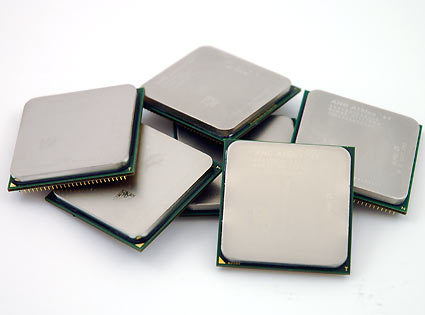AMD's Dual Core Athlon 64 X2 Strikes Hard
Athlon 64 Models Compared
| Processor | Model | Clock | Cache | Process | Core |
|---|---|---|---|---|---|
| Athlon 64 X2 | 4800+ | 2.4 GHz | 2x 1 MB | 90 nm | Toledo |
| Athlon 64 X2 | 4600+ | 2.4 GHz | 2x 512 kB | 90 nm | Manchester |
| Athlon 64 X2 | 4400+ | 2.2 GHz | 2x 1 MB | 90 nm | Toledo |
| Athlon 64 X2 | 4200+ | 2.2 GHz | 2x 512 kB | 90 nm | Manchester |
| Athlon 64 | FX 55 | 2.6 GHz | 1 MB | 130 nm | Clawhammer |
| Athlon 64 | 4000+ | 2.4 GHz | 1 MB | 90 nm | San Diego |
| Athlon 64 | 4000+ | 2.4 GHz | 1 MB | 130 nm | Clawhammer |
| Athlon 64 | 3800+ | 2.4 GHz | 512 kB | 90 nm | Venice |
| Athlon 64 | 3800+ | 2.4 GHz | 512 kB | 130 nm | Newcastle |
| Athlon 64 | 3500+ | 2.2 GHz | 512 kB | 90 nm | Venice |
| Athlon 64 | 3500+ | 2.2 GHz | 512 kB | 90 nm | Winchester |
| Athlon 64 | 3500+ | 2.2 GHz | 512 kB | 130 nm | Newcastle |
| Athlon 64 | 3200+ | 2.0 GHz | 512 kB | 90 nm | Venice |
| Athlon 64 | 3200+ | 2.0 GHz | 512 kB | 90 nm | Winchester |
| Athlon 64 | 3000+ | 1.8 GHz | 512 kB | 90 nm | Venice |
| Athlon 64 | 3000+ | 1.8 GHz | 512 kB | 90 nm | Winchester |
The table above shows all Athlon 64 processors currently available, with the exception of the X2 dual core models. AMD wants to announce them in June, with an official launch May 31 during Computex in Taipei, Taiwan. However, we do not expect the X2 to be widely available before Q3.
Some processor versions are marked red; these are the models that we no longer recommend, because they are based on the outdated 130 nm cores. They do support Cool & Quiet, and so are capable of reducing the core clock speed down to 1 GHz to save energy and reduce heat dissipation. But their larger feature size means they will consume more energy no matter what clock speed they are working at. In addition, the 90 nm Venice and San Diego cores also support the SSE3 extensions and come with small performance improvements. The streaming extensions, in particular, are proving to be useful with an increasing number of professional applications.
Currently, the Athlon 64 FX 55 can be considered the worst deal at AMD, since it is the most expensive product while based on the oldest core that is still shipping. The FX 57 will change this equation in AMD's portfolio.
Get Tom's Hardware's best news and in-depth reviews, straight to your inbox.
Current page: Athlon 64 Models Compared
Prev Page Performance Rating 4200+ To 4800+ Next Page Athlon 64 X2 Test System
Patrick Schmid was the editor-in-chief for Tom's Hardware from 2005 to 2006. He wrote numerous articles on a wide range of hardware topics, including storage, CPUs, and system builds.
-
thomasxstewart At time overpriced & people just wern't sure, after conroe & pricing problems of collaspe nature, by end of 2006 this was well established TOP End procesor.Reply
Coming to full fruitation by Summer '7.Yet, AM2 socket has been improved with on board main support(DDR3 & higher speed DDR2) of next level in AM2+, as well as AM3.
Signed:PHYSICIAN THOMAS STEWART VON DRASHEK M.D.
